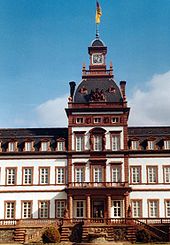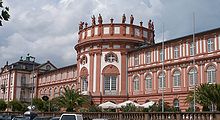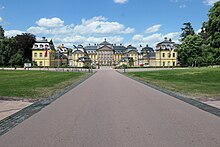Julius Ludwig Rothweil
Julius Ludwig Rothweil (* probably 1676 in Alsace ; † 1750 ) was a Hessian state architect (court architect) of the Baroque .
life and work
The exact date and place of birth of Julius Ludwig Rothweil is not yet known. He was probably born in Alsace in 1676. He received his professional training as a master builder in Strasbourg or Paris . In 1701, Rothweil in Hanau can be verified for the first time as an engineer.
From 1702 he was governor in the service of the princes of Nassau-Weilburg . Here he mainly worked as a construction manager for Weilburg Castle . During this time, however, he was also entrusted with construction projects in Neuwied , Hachenburg and Hanau . With the construction of the Philippsruhe Palace near Hanau (country palace for Count Philipp Reinhard von Hanau ), he attracted national attention. He then carried out important building work for various sovereigns, both churches and castles. His buildings became models in both areas, especially in the “Protestant Belt” between Berlin, Hanover, Kassel and Palatinate-Saarbrücken.
During his time as court architect of Count Johann Ernst von Nassau-Weilburg (1675–1719), he was responsible for all of the Count's major construction projects.
Around 1709 or 1710 he was called to Arolsen . In Arolsen he planned the palace, one of the most important palace complexes in Hesse. As building director of Count and Prince Anton Ulrich von Waldeck and Pyrmont (reign 1706–1728), he was responsible for all structural and civil engineering there. His successor as the Waldeck construction director was his son Franz Friedrich Rothweil (1702–1777), who continued his work after his father's death.
From 1732 to 1739, the corps de logis of Berleburg Castle of the Counts of Sayn-Wittgenstein -Berleburg was built according to plans by Rothweiler.
His work was influenced by the French baroque ( Versailles Palace ) and the Dutch baroque. In his work Rothweil mediated between the architectural styles of baroque and classicism. He was the pioneer of the classicist baroque in today's Hesse.
Julius Ludwig Rothweil died in 1750.
Executed buildings
- Philippsruhe Palace , Hanau: from 1701 (completed by the Parisian builder Jacques Antoine Vith Girard by 1712)
- Biebrich Castle : expansion and expansion, until 1703
- Neuwied Castle : from 1703 (plans from R. 1706/1707), originally planned with three wings, executed as three individual buildings
-
Weilburg :
- Expansion and expansion of the castle
- New construction of the castle church and town hall, 1703–1713. The castle church is considered to be the most important Protestant baroque church in Hesse
- Extension and extension of the Upper Orangery , 1703–1705
- New construction of the Lower Orangery, 1711–13, based on the model of the Orangery at Versailles
- Redesign of the market square and new administration buildings. The office now houses the mining and city museum.
- first aqueduct from Weilburg
- Hachenburg Castle : expansion, 1715–1746
- Höhnscheid Castle (manor house) and park: new building 1720–1730
-
Arolsen (residence of Prince Friedrich Anton Ulrich zu Waldeck and Pyrmont ):
- Arolsen Castle : demolished from 1710 and rebuilt 1713–1728
- City church (Arolsen) : new building 1735–1787
-
Bad Pyrmont :
- Castle : changed from 1721
- Commandant's house: new building in 1723
- Cavalier houses: new building in 1723
- Magazine building: new building in 1726
- Fortress: repair and reconstruction
- Berleburg Castle Corps de Logis 1732–1739
Authorship presumed
- Kirchheimbolanden : Castle church (Paulskirche): new building 1739–1744 (slightly modified duplicate of the castle church in Weilburg)
- Daaden (Westerwald): Protestant parish church, 1722–1724
Wrongly assigned authorship
- Neunkirchen / Westerwald , Protestant parish church (builder: Johann Michael Petri )
literature
- Birgit Kümmel , Michael Neumann, Ulrich Schütte (Eds.): Julius Ludwig Rothweil (1676-1750) , Petersberg: Imhof, 1st edition 2004, 2nd edition: 2006, ISBN 3-937251-19-7
- Magnus Backes : Julius Ludwig Rothweil: a Rhenish-Hessian baroque architect , Baden-Baden, Strasbourg: Heitz, 1st edition, 1959 (studies on German art history; 317)
- Magnus Backes: Neuwied Castle and its master builder Julius Ludwig Rothweil - Supplementary remarks and investigations , in: Johannes Mötsch (Ed.): Ein Eifler for Rhineland-Palatinate. Festschrift for Franz-Josef Heyen on his 75th birthday on May 2, 2003 (= sources and treatises on the history of the Middle Rhine church; 105), Vol. 2, pp. 1137–1152, Mainz, 2003
- Kathrin Ellwardt: Ev. Weilburg Castle Church . Regensburg 1999. (= Schnell & Steiner, Art Guide No. 2391). ISBN 3-7954-6218-5
- Birgit Kümmel, Richard Hüttel (ed.): Arolsen: meanwhile it wants to shine; a baroque residence , Korbach, 1992
Individual evidence
- ↑ Mining and City Museum (accessed April 10, 2014)
Web links
| personal data | |
|---|---|
| SURNAME | Rothweil, Julius Ludwig |
| BRIEF DESCRIPTION | Hessian baroque master builder |
| DATE OF BIRTH | around 1676 |
| DATE OF DEATH | 1750 |







